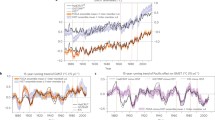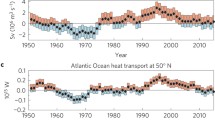Abstract
Past research on the climate response to orbital forcing has emphasized the glacial-interglacial variations in global ice volume, global-mean temperature, and the global hydrologic cycle. This emphasis may be inappropriate in the tropics, where the response to precessional forcing is likely to be somewhat independent of the glacial-interglacial variations, particularly in variables relating to the hydrologic cycle. To illustrate this point, we use an atmospheric general circulation model coupled to a slab ocean model, performing experiments that quantify the tropical climate’s response to (1) opposite phases of precessional forcing, and (2) Last Glacial Maximum boundary conditions. While the glacially-forced tropical temperature changes are typically more than an order of magnitude larger than those arising from precessional forcing, the hydrologic signals stemming from the two forcings are comparable in magnitude. The mechanisms behind these signals are investigated and shown to be quite distinct for the precessional and glacial forcing. Because of strong dynamical linkages in the tropics, the model results illustrate the impossibility of predicting the local hydrologic response to external forcing without understanding the response at much larger spatial scales. Examples from the paleoclimate record are presented as additional evidence for the importance of precessional signals in past variations of the tropical climate.












Similar content being viewed by others
References
Berger AL (1978) Long-term variations of daily insolation and quaternary climate changes. J Atmos Sci 35: 2362–2367
Broccoli AJ (2000) Tropical cooling at the last glacial maximum: an atmosphere-mixed layer ocean model simulation. J Clim 13: 951–976
Broccoli A, Manabe S (1987) The influence of continental ice, atmospheric CO2 and land albedo on the climate of the Last Glacial Maximum. Clim Dyn 1: 87–99
Broecker WS (1995) The glacial world according to Wally. 318 pp., Lamont-Doherty Earth Observatory, Palisades, NY, USA
Bush M, Miller MC, de Oliveira P, Colinvaux P (2002) Orbital-forcing signal in sediment of two Amazonian lakes. J Paleolim 27: 341–352
Chen P, Hoerling M, Dole R (2001) The origin of the subtropical anticyclones. J Atmos Sci 58: 1827–1835
Clement AC, Seager R (1999) Climate and the tropical oceans. J Clim 12: 3384–3401
Cortijo E, Lehman S, Keigwin L, Chapman M, Paillard D, Labeyrie L (1999) Changes in meridional temperature and salinity gradients in the North Atlantic Ocean (30–72N) during the Last Interglacial Period. Paleoceanology. 14: 23–33
Fine RA, Peterson WH, Ostlund HG (1987) The penetration of tritium into the tropical Pacific. J Phys Oceanogr 5: 553–564
Ganopolski A, Rahmstorf S, Petoukov V, Claussen M (1998) Simulation of modern and glacial climate with a coupled global model of intermediate complexity. Nature 391: 351–356
Gasse F (2000) Hydrological changes in the African tropics since the Last Glacial Maximum. Quat Sci Rev 19: 189–211
Hall A (2003) Role of surface albedo feedback in climate. Part I: internal climate variability. J Clim (in press)
Hall A, Manabe S (2000) The effect of water vapor feedback on internal and anthropogenic variations of the global hydrologic cycle. J Geophys Res 105: 6935–6944
Harrison SP, Kutzbach JE, Prentice IC, Behling JP, Sykes MT (1995) The response of Northern Hemisphere extratropical climate and vegetation to orbitally induced changes in insolation during the Last Interglaciation. Quat Res 43: 174–184
Hays JD, Imbrie J, Shackleton NJ (1976) Variations in the Earth’s orbit: pacemaker of the ice ages. Science 194: 1121–1132
Hewitt CD, Mitchell JFB (1997) Radiative forcing and response of a GCM to ice age boundary conditions: cloud feedback and climate sensitivity. Clim Dyn 13: 821–834
Hewitt CD, Broccoli AJ, Mitchell JFB, Stouffer RJ (2001) A coupled model study of the last glacial maximum: was part of the North Atlantic relatively warm? Geophys Res Lett 28: 1571–1574
Imbrie J et al (1984) The orbital theory of Pleistocene climate: support from a revised chronology of the marine δ18O record. In: Berger AL et al. (eds) Milankovich and climate. Reidel, Hingham, MA, USA, pp 269–305
Imbrie J et al (1992) On the structure and origin of major glaciation cycles, 1, linear responses to Milankovitch forcing. Paleoceanography 7: 701–738
Imbrie J et al. (1993) On the stucture and origin of major glaciation cycles, 2, the 100,000-year cycle. Paleoceanography 8: 699–735
Jackson CS, Broccoli AJ (2003) Orbital forcing of the Arctic climate: mechanisms of climate response and implications for continental glaciation. Clim Dyn (in press)
Joussaume S et al (1999) Monsoon changes for 6000 years ago: results of 18 simulations from the Paleoclimate Modeling Intercomparison Project (PMIP). Geophys Res Lett 26: 859–862
Joussaume S, Braconnot P (1997) Sensitivity of paleoclimate simulation results to the season definitions. J Geophys Res 102: 1943–1956
Joussaume S, Taylor K (1995) Status of the paleoclimate modeling intercomparison project (PMIP). In: Gates WL (ed) WCRP, pp 425–430
Khodri M, Leclainche Y, Ramstein G, Braconnot P, Marti O, Cortijo E (2001) Simulating the amplification of orbital forcing by ocean feedbacks in the last glaciation. Nature 410: 570–574
Kutzbach JE, Chervin RM, Houghton DD (1977) Response of the NCAR general circulation model prescribed changes in ocean surface temperature. Part I: mid-latitude changes. J Atmos Sci 34: 1200–1213
Kutzbach JE, Liu Z (1997) Response of the African monsoon to orbital forcing and ocean feedbacks in the middle Holocene. Science 278: 440–443
Lea DW, Pak DK, Spero HJ (2000) Climate impact of late Quaternary equatorial Pacific sea surface temperature variations. Science 289: 1719–1724
Lindzen RS, Hou AY (1988) Hadley circulations for zonally averaged heating centered off the equator. J Atmos Sci 45: 2416–2427
Lindzen RS, Pan W (1994) A note on orbital control of equator-pole heat fluxes. Clim Dyn 10: 49–57
Manabe S, Stouffer RJ (1980) Sensitivity of a global climate model to an increase of CO2 concentration in the atmosphere. J Geophys Res 85C10: 5529–5554
Manabe S, Wetherald RT (1975) The effects of doubling CO2 concentration on the climate of a general circulation model. J Atmos Sci 32: 3–15
Milankovitch M (1920) Theorie Mathematique des Phenomenes Produits par la Radiation Solaire. Gauthier-Villars, Paris, France
Mitchell JFB, Johns TC, Gregory JM, Tett SFB (1995) Climate response to increasing levels of greenhouse gases and sulfate aerosols. Nature 376: 501–504
Otto-Bliesner BL (1999) El Nino/La Nina and Sahel precipitation during the middle Holocene. Geophys Res Lett 26: 87–90
Paillard D (2001) Glacial cycles: toward a new paradigm. Rev Geophys 39: 325–346
Peltier W (1993) Time dependent topography through a glacial cycle. IGBP PAGES/World Data Paleoclimatology Program, Boulder CO, USA
Phillipps PJ, Held IM (1994) The response to orbital perturbations in an atmospheric model coupled to a slab ocean. J Clim 7: 767–782
Pinot S et al (1999) Tropical paleoclimates at the Last Glacial Maximum: comparison of Paleoclimate Modeling Intercomparison Project (PMIP) simulations and paleodata. Clim Dyn 15: 857–874
Porter SC (2001) Snowline depression in the tropics during the Last Glaciation. Quat Sci Rev 20: 1067–1091
Prell WL, Kutzbach JE (1987) Monsoon variability over the last 150,000 years. J Geophys Res 92: 8411–8425
Raymo M, Nisancioglu K (2003) The 41 kyr world: Milankovitch’s other unsolved mystery. Paleoceanography 18, doi: 10.1029/2002PA000791
Rind D, Peteet D, Kukla G (1989) Can Milankovich orbital variations initiate the growth of ice sheets in a general circulation model? J Geophys Res 94: 12,851–12,871
Rodwell MJ, Hoskins BJ (1996) Monsoons and the dynamics of deserts. Q J R Meteorol Soc 122: 1385–1404
Rodwell MR, Hoskins BJ (2001) Subtropical anticyclones and monsoons. J Clim 14: 3192–3211
Seager R et al (2002) Is the Gulf Stream responsible for Europe’s mild winters? Q J R Meteorol Soc 28: 2563–2586
Shackleton NJ (2000) The 100,000-year ice-age cycle identified and found to lag temperature, carbon dioxide and orbital eccentricity. Science 289: 1897–1902
Shin SI, Liu Z, Otto-Bliesner BL, Brady EC, Kutzbach JE, Harrison SP (2003) A simulation of the Last Glacial Maximum climate using NCAR-CCSM. Clim Dyn (in press)
Thompson LG et al (1998) A 25,000-year tropical climate history from Bolivian ice cores. Science 282: 1858–1864
Thompson LG, Mosley-Thompson E, Lin P-N, Mashiotta TA (2002a) Ice core evidence of past changes in the hydrological cycle of the tropics and subtropics. Eos Trans, AGU, Fall Meeting Suppl 83: Abstr PP61B-02
Thompson LG et al (2002b) Holocene climate change in the tropics: evidence of abrupt climate change past and present. Nature (in press)
Thompson LG et al (2002c) Kilamanjaro ice core records: evidence of Holocene climate change in tropical Africa. Science 298: 589–593
Thompson LG et al (1995) Late glacial stage and Holocene tropical ice core records from Huascaran, Peru. Science 269: 46–50
Trauth M, Denino A, Bergner A, Strecker M (2003) East African climate change and orbital forcing during the last 175 kyr BP. EPSL 206: 297–313
Trenberth KE, Stepaniak DP, Caron JM (2000) The global monsoon as seen through the divergent atmosheric circulation. J Clim 13
Zhang Y, Wallace JM, Battisti DS (1997) ENSO-like decade-to-century scale variability: 1900–93. J Clim 10: 1004–1020
Acknowledgements.
The authors wish to thank Claes Rooth, Mark Maslin and two anonymous reviewers for their comments. A.C was supported by National Science Foundation CAREER grant #ATM-0134742 and National Science Foundation grant #ATM-9986515. A.H. was supported by National Science Foundation CAREER grant ATM-0135136. A.J.B was supported by New Jersey Agricultural Experiment Station Project NJ07167.
Author information
Authors and Affiliations
Corresponding author
Rights and permissions
About this article
Cite this article
Clement, A.C., Hall, A. & Broccoli, A.J. The importance of precessional signals in the tropical climate. Climate Dynamics 22, 327–341 (2004). https://doi.org/10.1007/s00382-003-0375-8
Received:
Accepted:
Published:
Issue Date:
DOI: https://doi.org/10.1007/s00382-003-0375-8




